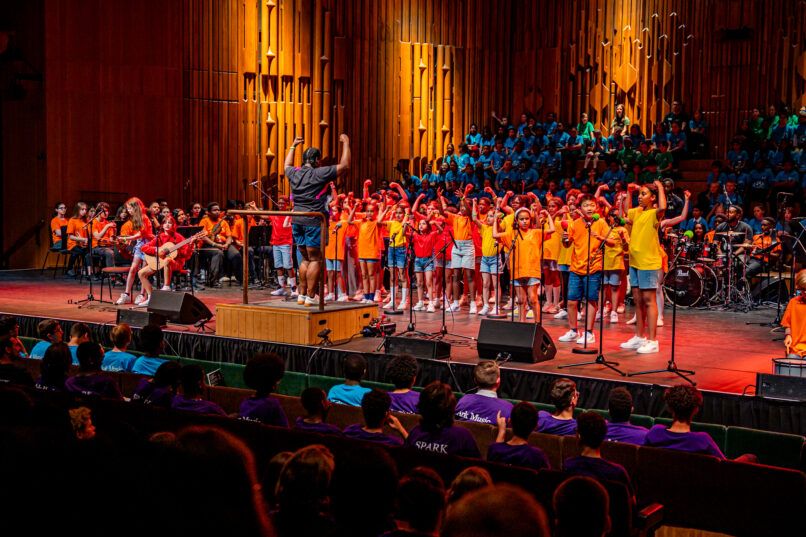

“What would life be, without a song or a dance?” a famous Swedish band once said.
Yet sadly, arts education, including music, has been sending out an SOS for some time, with GCSE enrolments in arts subjects down 47 per cent since 2010 and with disproportionate numbers of children from low-income backgrounds missing out.
The arts, though, bring cohesion and joy to schools, giving students unique opportunities to learn to express themselves, develop critical thinking, and see the world from different perspectives. These skills, valuable in their own right, are also essential for success beyond school.
This is why we are delighted that 10 per cent of our students now take music GCSE, double the national average; in some schools, this rises to 30 per cent. More importantly, an equal number of Ark’s free school meal students take music GCSE and an equal proportion pass.
While none of this happened overnight, these are some of the key things we have done that could prove useful for other trusts or schools.
1. Teacher CPD
A key focus has been ensuring pupils have a strong grounding in musical education at the start of school.
As such, we have made CPD for teachers on music delivery a key focus and often bring in primary music specialists to coach teachers in their classrooms. As a result, 90 per cent of our primary teachers now say they enjoy their music teaching.
We also created our own curriculum resources to help teachers have the confidence to deliver music lessons.
2. Time to teach
Building on this as part of our belief in providing a broad curriculum for all our primary and key stage 3 pupils, we offer an hour per week of music lessons.
We also run a Year 10 music day for all GCSE students from across the network to come together and kick-start their course.
We also help schools provide opportunities outside of lessons – for example, offering training and resources such as age-appropriate repertoire to backing tracks, setting up a choir and committing to free peripatetic lessons for those in receipt of pupil premium funding.
3. Working in harmony
By working in partnership with other schools we can provide more opportunities than operating alone.
For example, schools work together on choirs, ensembles and rap collectives to give students more opportunities to take part in diverse musical collaboration than a single school department could offer. Our 80-piece fusion orchestra, which includes children from 19 of our schools, is a good case in point.
We have also found ways for staff to work together. For example, we have a shared curriculum, assessment and resources (designed by teachers in our schools), which we moderate together. This makes peer support much easier – experienced heads of department can support others in the same region as they are all working from the same plan.
We also run peer visits and regular trust-wide meetings, and enable informal connections to help share best practice, support and ideas.
4. Fundraising opportunities
While the majority of this is funded from school budgets, we also fundraise. There are trusts and foundations, as well as private individuals with an interest in equalising access to the arts.
Many of our schools engage with their local community and secure funding from their local branch of Tesco, while some have secured grant funding from organisations such as Restore The Music to fund the purchase of musical instruments.
It’s always worth investigating this as it can have a meaningful impact on what you can offer.
5. Performing together
We have always held a biennial music gala at the Barbican, but this year we had the opportunity to do something new.
With the generous support of the Clore Duffield Foundation, we developed a pilot to take our music model and apply it to wider arts access so we could work with arts organisations and boost teacher training.
Teachers across the network had training from experts from the National Theatre, Tate and the Royal Opera House. We had a particular focus on our schools in Hastings, where we produced a week-long arts festival that has seen pupils benefit from over 2,400 hours of arts engagement.
Furthermore, 3,000 children in our schools in Hastings worked with local artists, local collectives such as Radiator Arts, regional agencies like South East Dance and Apples and Snakes, as well as national organisations such as Punchdrunk Enrichment as part of this innovative project.
While these ideas may require adaptation to your setting, hopefully they can help ensure more pupils have the chance to say, “Thank you for the music”.
This article was written by Margaret O’Shea, Head of Extended and Creative Curriculum at Ark, and originally published by tes magazine on Tuesday 16 July 2024.
Latest news and opinion
-
News12th December 2025
Ark’s future primary leaders celebrate graduation at EdCity
-
News5th December 2025
Time in Art: How do we keep creativity alive in schools?
-
News7th November 2025
Ark Start is closing the ‘disadvantage gap’, says Education Policy Institute